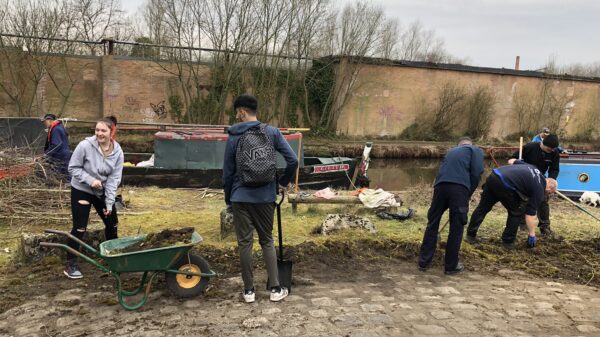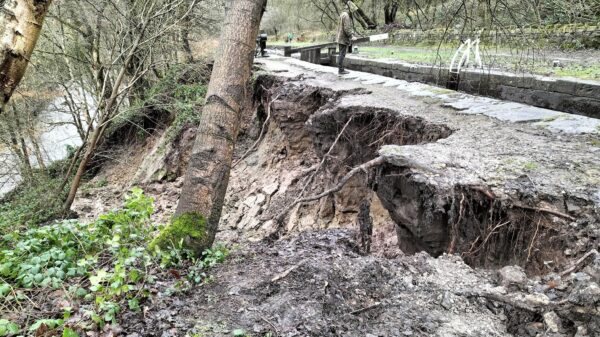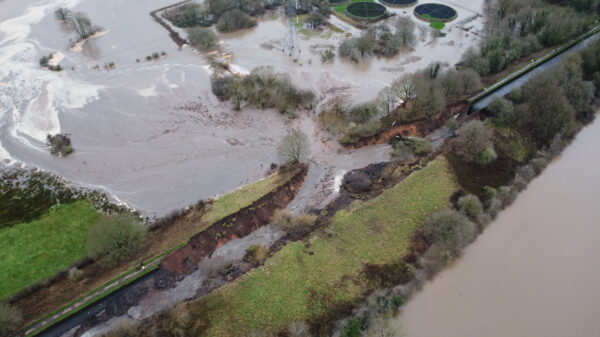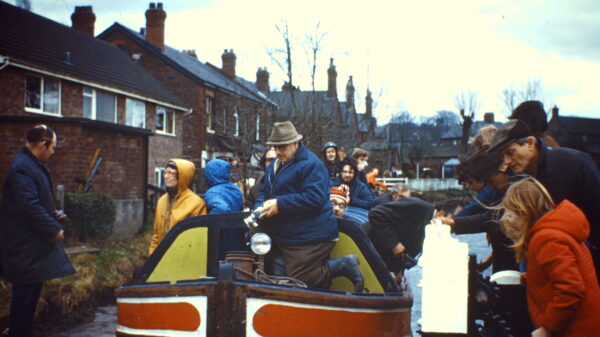What follows below is a slightly modified version of an article, by Martin Ludgate, that appears in Navvies 324. You can subscribe to Navvies here, from only £5 per annum.
Until around 1960 it was possible for boats to make a through journey east-west through the centre of Manchester. From the Bridgewater Canal at its Castlefield Basin terminus to the west of the city centre, the surviving one-mile length of the Rochdale Canal climbed through nine locks (the ‘Rochdale Nine’) to Ducie Street Basin. Beyond there, the main trans-Pennine length of the Rochdale Canal had been abandoned (with little hope of reopening), but the Ashton Canal turned right and climbed another 18 locks to Dukinfield Junction. Here the Huddersfield Canal (generally regarded as another hopeless case) continued straight ahead, but boats could turn right into the Lower Peak Forest Canal, then cross Marple Aqueduct and climb Marple Locks to join the Upper Peak Forest and Macclesfield canals. From there, the Macclesfield led to the Trent & Mersey, which in turn connected to the Bridgewater, completing a 100-mile circuit – which waterways supporters later dubbed the ‘Cheshire Ring’.
However, by 1960 the Rochdale Nine, the lower Peak Forest, and particularly the Ashton, were falling into disrepair through lack of use and maintenance since the ending of commercial freight traffic. A campaign cruise involving North Cheshire Cruising Club and IWA was organised in 1961 to attempt to draw attention to the route and keep it open – but the night before it was due to take place, vandals set fire to a set of bottom lock gates on the Ashton. One boat still got through (it was a small cruiser, and it was bodily dragged out of the water and around the lock), but that was the end as far as through navigation was concerned.
For the next decade, waterway supporters and organisations including IWA and the Peak Forest Canal Society campaigned to reopen the route, in the face of practical issues (there were serious problems with Marple Aqueduct, which was threatened with demolition at one point) and political ones (some local authorities on the route wanted the canals eliminated as a health and safety hazard), not to mention the cost of restoration. And then there was the attitude of the then privately-owned Rochdale Canal Company who threatened to abandon their canal – as well as British Waterways Board who took the Lower Peak Forest and Ashton off the cruising licence and put signs up warning boaters not to attempt to navigate these canals.
[The photo shows a derelict lock at Clayton on the Ashton Canal, taken between 1966 and 1968 – IWA collection, unknown photographer]
To cut a very long story short, by the start of the 1970s the tide of opinion was turning. The first of the ‘Big Digs’, Operation Ashton, had brought several hundred volunteers to spend a weekend clearing a huge amount of rubbish from the canal; this was followed in 1972 by Ashtac, when 1000 volunteers working on the Ashton and Peak Forest launched the final push to reopen the two canals. Issues of Navvies from 1973 show plenty of working parties on these canals, with volunteers from as far away as the IWA London Working Party Group (predecessor of London WRG), who were urged “We must have a big turnout of London navvies to work on this most important of waterways”. A review in early 1973 shows a Cheshire Ring making good progress towards reopening, with work shared between BWB and the volunteers. On the Ashton…
“Under the experienced leadership of area engineer John Freeman, things have certainly moved. BWB have given priority in four main fields: (1) work the two aqueducts, (2) land-based dredging projects, (3) supplying and fitting lock gates, (4) preparation of lock chambers (pointing, rebricking etc). (1) and (2) are all but complete; (3) and (4) are progressing to programme. On the volunteer front, lock chamber clearance has had 95% of the available time.”
[The photo shows Beswick Lock 5, before restoration – supplied, many years ago, by BWB’s Wigan office]
Meanwhile on the Peak Forest…
“Progress on the Marple flight has been less visibly dramatic, only 5 new gates being in position to date. In addition, much of the gating is to be retained. BWB has given priority to two main fields: (1) lock works on the top section of the flight, (2) commencement of the floating dredger programme on the lower Peak Forest. On the volunteer front, chamber clearance has again had 96% of the work.”
Finally, things were less clear on the Rochdale Nine, which in theory were in a better state…
“This canal is NOT navigable, as those who would describe it as navigable do so at their own peril. This canal was put into ‘basically operable’ order by the Peak Forest Canal Society working party aided by the Rochdale Canal Company and WRG etc for the Manchester Rally two years ago. The canal has steadily deteriorated since; the scope of the working parties by no means keeping up with the decay. The unofficial position remains in a state of flux, but you can rest assured that the position is in the forefront of our ‘Ring’ consciences…”
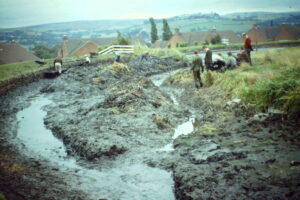
[The photos show scenes from the ‘Marple Assault’ work party of 1969 – notes from the work party, provided by the late Robin Higgs are available here.]
Meanwhile an untimely breach had shut the Bridgewater Canal near Lymm, and the Canal Company’s contractors were hard at work on a site that “resembles a motorway construction project” to rebuild it. The writer (Pete Stockdale) concluded by saying that at the one-year stage, “we are about one third of the way to a complete Ring.” By summer 1973, Navvies was quoting a ‘deadline’ of April 1974 for completion of the Ashton and Peak Forest, and urging volunteers to turn up and help make this happen – and in doing so, to provide “a stick to beat the owners of the Rochdale into repairing their part”.
By Autumn there was less to say about the Ashton as the volunteer contribution was nearing completion but on the Peak Forest, while Marple Locks were progressing, dredging was behind schedule and “we would like to see a bit of ‘extractum digitum’.” And on the Rochdale Nine, the Canal Company had put up some cash and were to carry out the necessary gate replacements as well as funding plant hire etc for the volunteers who appeared to have been ‘volunteered’ in their absence to do the chamber clearances – and “some sort of navigational prospects” were hoped for by April 1974.
Come the end of the year, and Navvies was still referring to “the target date of 1 April 1974 for the reopening of the Cheshire Ring”. In February, two months before the opening date, the following issue reported that on the Ashton and Peak Forest “the volunteer effort is now complete”, with BWB just putting the finishing touches on what had been “a superb job, a lasting credit to John Freeman”.
[The photo shows a lock gate for Marple Locks, being built by Peak Forest Canal Society volunteers! The lock beams were engraved ‘PFCS’ ]
Things were less happy on the Rochdale Nine, where “Working party organisers had been led to believe that the finance of the operation, which was to have started on 4 January and conclude by 1 April had had the necessary clearance,” but “due to official bungling, volunteer work is now at a standstill”. Some money was loaned, and one of the nine locks was cleared (By an interesting technique involving craning a Smalley excavator into the chamber).
April came, and the Cheshire Ring wasn’t ready to open. The Ashton and Peak Forest were officially opened on 13 May, but on the Rochdale, although once the funds had been confirmed the volunteers did a large amount of difficult work clearing lock chambers with very awkward access, the Canal Company’s gate fitting programme had only just started, with no completion date available other than it might possibly open in “mid-summer”.
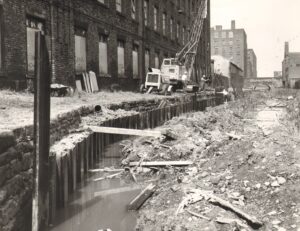
[The photo above shows installing new piling during restoration work, looking towards Bridge 5 at Ancoats on the Ashton Canal. The photo left shows restoration work at Dukinfield Junction, also on the Ashton Canals – photos from IWA collection, photographer unknown, but probably Harry Arnold]
It didn’t. The August issue of Navvies said “Despair is the only word to describe the situation with regard to the completion of the restoration of the last link in the Cheshire Ring.” The canal company had made no progress with the gates, and in the meantime the reopened but barely used Lower Peak Forest and Ashton were starting to suffer from weed growth and vandalism. One more set of gates had gone in by October. In December the “provisional official estimate” for the completion date had slipped to February 1975 – which is, of course, outside the scope of this article about the glorious year of 1974. That might seem nit-picky (and it is!) but perhaps less so when you hear that it actually took another whole year beyond that for the Rochdale Canal company to get its act together so that the Rochdale Nine – and therefore the complete Cheshire Ring – could finally reopen in 1976.
Finally, to end on a positive note, those two ‘hopeless’ cases I referred to earlier, the main trans-Pennine length of the Rochdale Canal and the (also trans-Pennine) Huddersfield Canal were both the subject of restoration plans launched in 1974 in the wake of the completion of the Ashton and Peak Forest restorations. And they reopened throughout in 2002 and 2001 respectively.
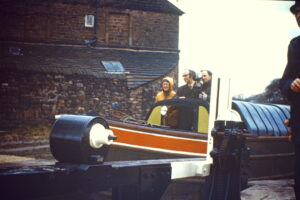
[The photo, above, shows the then Prince Charles with the then Mayor of Stockport on a 1981 visit to Marple to launch the community boat New Horizons – Photo by Frank Bennett. The photos below and title, show the first private boat through the locks, the narrowboat ANT at Top Lock No. 16, from the 1974 reopening at Marple Locks – both photos by Brian Beagley.]

